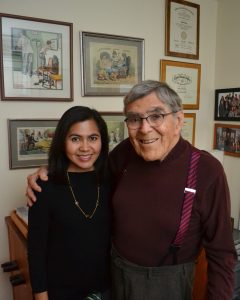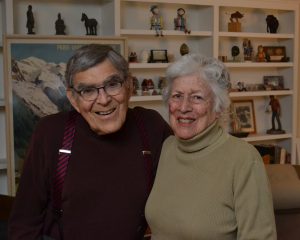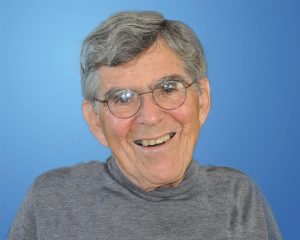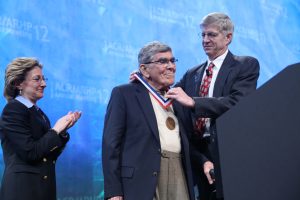Editor’s note: We are sad to report that Dr. Kaplan passed away on Saturday, June 23. We are reposting this story now to celebrate his life. Read his obituary.
In a growing specialty that is still largely underserved, there is always a spark of excitement and an unspoken sense of camaraderie when one rheumatologist meets another in the most unexpected places. I met Herbert Kaplan, MD, during a trip to Massachusetts to see my parents-in-law at the retirement community they had just moved into. Both retired physicians, they were eager to share the news that their newfound friend in the building happened to be a rheumatologist like me and was a past president of the ACR.
I vaguely recognized the name, but I didn’t know much about Dr. Kaplan. I was just in my last year of medical school when he was ACR president (1993–94). I decided to make it a point to sit down and chat with Dr. Kaplan whenever I was in town, and I exchanged occasional emails with him. The more I got to know Dr. Kaplan, the more I felt compelled to share the story of how I met him with not just a few colleagues, but to make sure this and future generations of rheumatologists know about Dr. Kaplan’s contributions to the advancement of our specialty.
I asked Dr. Kaplan for a formal interview about his life, which he gladly obliged. I was like Marty McFly in Back to the Future, with an accidental chance to see the life of my version of Doc Brown. In the end, I learned so much about the history and the future of rheumatology.
Dr. Kaplan’s Early Career
Born in New York in 1929, the son of a high school math teacher and a mother who stayed home to care for three children, Dr. Kaplan was the first in his family to become a doctor, obtaining his MD from Albany Medical College in 1955. I asked him why he chose to go into medicine.
“I really liked my high school biology teacher, Mr. Nathans,” was his quick reply.
But why did he choose rheumatology, which was not an established specialty around that time?
It all began in Germany. Dr. Kaplan went into the U.S. Army after completing his internal medicine residency at Duke University and Yale New Haven Hospital. He was working at the army hospital in Munich when he took care of 15 U.S. soldiers, all African American, who had sarcoidosis, acute arthritis and elevated uric acid levels. He decided to treat them with colchicine, mainly because they had elevated uric acid levels. Surprisingly, they all got better. As far as he knows, it was the first time colchicine was used for anything other than gout.
This experience got him interested in arthritis and rheumatology, and he wrote two articles about using colchicine in sarcoid arthritis, which were published in the New England Journal of Medicine in 1960 and 1963.
After getting out of the army in the early 1960s, Dr. Kaplan moved his family to Denver and started a rheumatology practice in the office of a general internist. At that time, the University of Colorado was the site for one of only nine rheumatology training programs in the country, although it was yet to be recognized as an official subspecialty of internal medicine. He diligently made rounds every Tuesday for several years with Charley Smyth, MD, whom he considers one of the founders of rheumatology and the one person who had the greatest influence in his career. Dr. Kaplan took the very first rheumatology board exam in 1974.
Dr. Kaplan eventually joined the voluntary faculty at the University of Colorado in Denver, where he received numerous teaching awards. He was the first Distinguished Clinical Professor of Medicine at the university. He also started the Denver Arthritis Clinic with Walter Briney, MD. They instituted a multidisciplinary approach in their clinic, and hired and trained physical therapists, occupational therapists and nurses who were all interested in learning how to care for arthritis patients.
Activism
Having a busy clinical practice and teaching responsibilities did not stop Dr. Kaplan from getting involved with the American Rheumatism Association (ARA), the predecessor of the ACR. I asked what motivated him to serve.
He said, “I believed in rheumatology, then a young and poorly recognized subspecialty of internal medicine, which should get more widespread recognition. It is a travesty to not be at the same level of importance as cardiology or pulmonology.” It was not a surprise that his earliest involvement was to be the ARA representative to the American Society of Internal Medicine, focusing his efforts on having rheumatology considered a subspecialty of internal medicine. Through the years, he took on broader responsibilities and more important leadership positions within the ACR, culminating in his induction as the president of the College in 1993–1994.
In parallel, Dr. Kaplan was also active with the Arthritis Foundation, becoming chair of the Board of Directors of the Rocky Mountain Chapter from 1988–1990 and fostering connections with the ACR.
When Dr. Kaplan became the ACR president, Mark Andrejeski, current executive vice president of the ACR, asked him what his goal was for his one-year tenure. Dr. Kaplan clearly remembers his response, “I wanted to facilitate participation of practicing physician members to attain leadership in the College.”
Paulding Phelps was the very first private practitioner to become ACR president. Dr. Kaplan was second. He recognized the importance of keeping clinical practice and research unified in academic and private practice settings.
I reassured him that this initiative is alive today. With the generous donation of Norman Gaylis, MD, a rheumatologist in private practice in Florida, the Rheumatology Research Foundation has expanded its portfolio to include a Research Award for Rheumatologists in Community Practice.
Dr. Kaplan understood the urgent need, which remains to this day, to attract more physicians to the field of rheumatology. In his 1994 ACR presidential address, published in Arthritis & Rheumatism, he strongly voiced his concern, “I am more worried that patients with rheumatic disease in the next century will not have available the expertise of a specialist in rheumatic diseases. I am worried about the long-term viability of our subspecialty.”
He advocated for looking for candidates as early as medical school or at the post-graduate level. His strategy also encompassed identifying those with leadership potential and takes pride in recruiting Elizabeth Tindall, MD, Neal Birnbaum, MD, Joe Croft, MD, and James O’Dell, MD, to serve in the ACR, all of whom later served as ACR presidents. Family members are fair game to Dr. Kaplan as well. His presidential address was actually titled, “My Granddaughter, the Rheumatologist.” Michelle was just seven-and-a-half years old at the time, but he opened with a bold statement that he would like her to become a rheumatologist. As it turns out, Michelle did not go into medicine, but into psychology. She now has a 6-year-old son, Drake. I told Dr. Kaplan, “Maybe your great-grandson will be the rheumatologist”—nothing like a ray of hope to brighten the day for a retired rheumatologist.
Honors & Awards
Throughout his professional career, Dr. Kaplan was honored with several awards. He was inducted as an ACR Master (1995) and was the recipient of the Paulding Phelps Award for outstanding service to patients, community and the practice of medicine (1996).
The award he is most proud of is the ACR Presidential Gold Medal, which he received in 2012. The Presidential Gold Medal is the highest award that the ACR can bestow, in recognition of outstanding achievements in rheumatology over an entire career. It had never been given to a rheumatologist in private practice until Dr. Kaplan. Such a befitting honor for someone who served our specialty and championed the cause of rheumatologists around the country who dedicate their lives to treating patients day in and day out.
Rodnan Gout Prints
Perhaps the most fun fact I learned about Dr. Kaplan is that he had something to do with the ubiquitous Rodnan Gout Prints showcased at each ACR/ARHP Annual Meeting. When Dr. Kaplan got interested in old rheumatology prints, he visited a shop in London looking for items to add to his collection. He was told that a doctor in Pittsburgh had already requested that any old arthritis print that came into the shop be shipped to him.
When Gerald Rodnan passed away, Dr. Kaplan contacted his daughter. He went to Pittsburgh with Mark Andrejeski and was led to the basement, where a big pile of prints lay on the concrete floor. Dr. Kaplan came up with the idea of making reprints of the originals to sell to members for the benefit of the ACR. One of the original prints from Dr. Rodnan’s collection hangs on the wall of Dr. Kaplan’s study.
Retirement
Dr. Kaplan retired from practice in 2000, and this is what he said in his retirement letter to his patients, “It is so ironic that at a time when dramatic advances have happened to my specialty that I have chosen to retire.”
He still tries to keep up with what’s going on in rheumatology by reading online journals, but noted that so much has changed and everything is advancing so fast, that at one point it was scary for him. I completed my rheumatology fellowship the same year he retired (2000), and I can say that yes, so much has changed, for the better.
Early in his retirement, he and his wife of 68 years, Beatrice (he fondly calls her Bea), spent time snowshoeing and cross-country skiing. They used to be big enthusiasts of downhill skiing, water skiing, sailing and canoeing. They also liked to travel and have taken 85 foreign trips during their time together. Until five years ago, Dr. Kaplan was into photography, and one of his photos made it to the cover of the Archives of Internal Medicine in May 2004.
Fast forward to 2018: Now Dr. Kaplan’s week is busy with doctor’s visits, participation in the Health and Wellness Committee and Dining Committee where he and his wife live, and dinner conversations with my physician parents-in-law. Once in a while, he puts his rheumatology hat on and answers questions in the hallway about everyone’s aches and pains. There are certainly plenty to go around in a retirement community.
4 Lessons for Young Rheumatologists
As we were wrapping up the interview, I asked him what advice he wants to give to young rheumatologists. He talked about four things.
- Take time off for vacation.
- Treat your employees/staff well.
- Be a mentor; you learn by teaching.
- Get involved with the ACR, because who knows, you may be president someday.
Finally, I asked how he sees the future of rheumatology. “Magnificent! Look at all we have to offer other specialties—advances we made are also advancing other fields. We have gone from aspirin to biologics. We don’t see people with horribly crippled joints anymore,” Dr. Kaplan said with a big smile on his face.
With that, my journey through time came to an end, and I am back to the future. I am inspired by Dr. Kaplan’s story and hope that all of us who carry the torch forward for rheumatology find ways to make a difference, not just for our patients but for each other.
Aileen Lorenzo Pangan, MD, is a rheumatologist and executive medical director, immunology development at AbbVie. She also serves on the Development Advisory Council of the Rheumatology Research Foundation.






